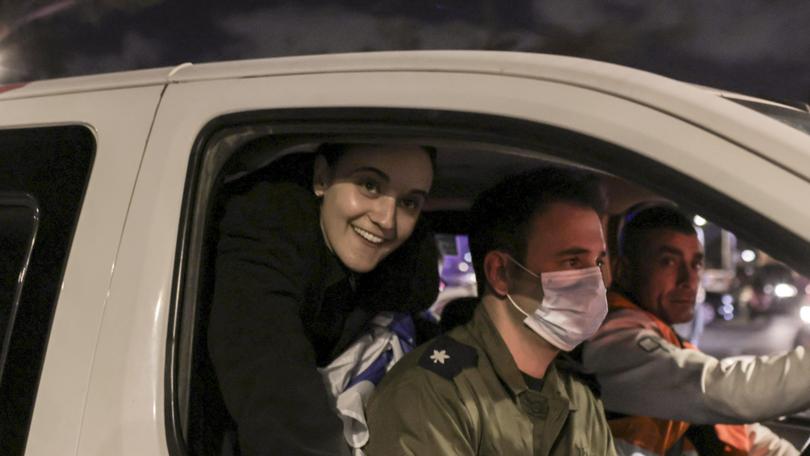THE NEW YORK TIMES: ‘Dad, I came back alive!’ Israeli hostages start to give glimpses of ordeal

JERUSALEM — Doron Steinbrecher vowed that she would never wear pink again when she made her first public comments in a video after being freed from more than 15 months in Hamas captivity in the Gaza Strip.
A year ago, she had appeared in a hostage video made by her captors wearing a pale rose-coloured sweatshirt. When the Palestinian militant group Hamas released her last month, she was dressed in a bright magenta track suit and looked pale.
Sitting in front of a camera again took her back to the difficult moments when her captors filmed her in Gaza, Steinbrecher, 31, said in the video, looking composed and smiling at times.
Sign up to The Nightly's newsletters.
Get the first look at the digital newspaper, curated daily stories and breaking headlines delivered to your inbox.
By continuing you agree to our Terms and Privacy Policy.“This time, I’m sitting comfortably on a couch with my family watching me in a warm and pleasant place,” she said. Trying to convey that she had not been broken, she said it was important for her to show everyone that “I’m OK.”
As families and sympathisers at home and abroad doggedly campaigned for the release of the Israeli hostages, most people knew them only as faces staring out from posters. Now, with 16 Israelis released since Jan. 19 under the ceasefire deal with Hamas, those haunting faces are coming to life in video clips, social media posts and statements from relatives that provide glimpses of the joy and relief of freedom as well as hints of the torment they have endured.
The brief messages they have sent out have mostly been expressions of gratitude to all those who worked for their release and pleas not to give up until the last hostage is freed.
The urgency of that message became even clearer Saturday, when many Israelis were shocked to see the emaciated condition of the latest three hostages who were released: Eli Sharabi, 52; Or Levy, 34; and Ohad Ben-Ami, 56.
Some relatives have said that the hostages released earlier were often deprived of food, suffered severe loss of weight and muscle mass and rarely saw sunlight. Family members said some of the hostages had at least occasional access to radio or television and heard or saw their relatives campaigning for their release, which helped them survive.
Col. Avi Benov, a doctor and deputy chief of the Israeli military’s medical corps, told reporters that several of the recently released female hostages had spent the past eight months underground in Hamas tunnels in Gaza. Some hostages who were released in November 2023 have described suffocating humidity in the tunnels that made it difficult to breathe.
Benov said the first seven women recently released were all suffering from “mild starvation,” while some still had shrapnel in their bodies from injuries they sustained on Oct. 7, 2023.
That was the day Hamas led an attack from Gaza on southern Israel that ended with about 1200 dead and about 250 people taken back to Gaza as hostages. The attack ignited a 15-month war, with Israel’s offensive in Gaza killing tens of thousands of Palestinians and devastating the territory.
Of the roughly 250 captives, scores were released during a week-long truce later that year, while some have been killed in captivity. More than 70 hostages have not yet been returned, including at least 35 who are believed to be dead, according to the Israeli government.
A total of 25 hostages are expected to be released, along with the bodies of eight others, during the initial six-week ceasefire that took effect last month.
They are being exchanged for about 1500 Palestinian prisoners, some of them convicted of killing Israelis. Released Palestinians, many of whom had been held without charge, say they faced harsh conditions in Israeli jails and detention facilities.
Some of the Israeli hostages had been forced to appear in videos filmed by their captors in Gaza — a practice that rights groups have denounced as inhumane treatment that could amount to a war crime. Israeli officials have called these a form of psychological warfare.
A few months ago, Hamas’ military wing issued a statement claiming that a hostage had been killed and released blurry images apparently showing a body wrapped in a shroud. One close-up shot showed a tattoo identical to one belonging to Daniella Gilboa, one of a number of female lookout soldiers captured from a small military base near the Gaza border.
But Gilboa, 20, was freed Jan. 25. Days later, she was singing at a party marking the discharge of the army lookouts from Beilinson Hospital near Tel Aviv.
She reflected on her ordeal in a lengthy Instagram post on Feb. 2. She said her faith and observance of Jewish rituals had gotten her through. She thanked her supporters for not believing the rumours that she had been killed in Gaza.
Liri Albag, another one of the lookouts, celebrated her 20th birthday while recovering at the hospital.
Steinbrecher was kidnapped from her home in Kfar Aza, a rural community near the Gaza border.
In the video she released, her appearance contrasted sharply with hostage videos made when she was pale, with blond hair pulled back in a braid. Her hair was now dark and neatly styled in a shoulder-length bob, and she dressed in black, wearing long necklaces, a dog tag and a yellow pin in solidarity with the hostages. She said she was no longer that person in the videos from Gaza.
“I’m Doron. I’m 31. I’m no longer in Hamas captivity, and I’m home,” she said.
The recently released hostages have remained largely protected from the glare of the news media and have not given any interviews so far. Medical and mental health professionals say that preserving their privacy is essential to the long healing process.
Footage released by the military of the hostages’ emotional reunions with close family members has given a sense of the elation surrounding their return.
“Dad, I came back alive!” another freed hostage, Romi Gonen, 24, shouted into a cellphone after being reunited with her mother on Jan. 19.
Experts say that the long captivity caused physical and psychological harm, and that full rehabilitation will take time.
“We are walking a very slow path,” said Noa Eliakim-Raz, the head of the returnees’ ward at Beilinson Hospital. “Of course, we see ups and downs. Every day is different.”
Some of the freed hostages returned with injuries from the Oct. 7 assault. Emily Damari, 28, lost two fingers after being shot in the hand and was also shot in the leg.
She is a fan of the Israeli soccer team Maccabi Tel Aviv, and at one of their matches last Monday, a video message from Damari was projected on a huge screen. She thanked the players, the management and the supporters for fighting for her freedom.
Gonen is still suffering from an arm injury and will need complicated surgery, her mother has said.
Gadi Moses, 80, an agronomist who was kidnapped from his home in Nir Oz, a village near the Gaza border, was released Jan. 30, appearing gaunt. Almost as soon as he returned to Israel, he pledged to do all he could to rehabilitate his ravaged community.
His niece, Efrat Machikawa, later told reporters that Moses had been kept above ground throughout his captivity but was frequently moved around.
Shut in rooms alone, she said, he exercised by counting steps and pacing up to 6 miles a day, kept his mind active with calculations and other techniques. And he remained positive.
When she first met him in the hospital, he reassured her: “I’m alive. I’m normal!”
“Loneliness becomes an enemy,” Machikawa said. “He managed to create a routine that kept his sanity.”
This article originally appeared in The New York Times.
© 2025 The New York Times Company
Originally published on The New York Times
